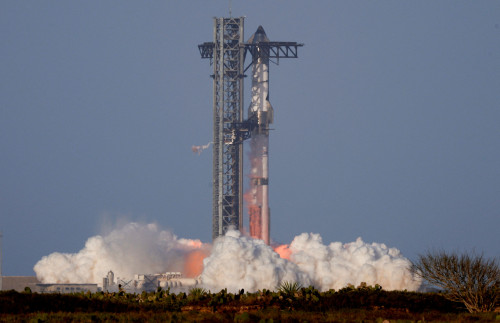By Joey Roulette
WASHINGTON (Reuters) -SpaceX received key U.S. regulatory approval on Tuesday to increase the annual rate of Starship rocket launches from Texas and booster landings in various bodies of water, allowing Elon Musk’s space company to significantly expand development of its giant Mars rocket.
The Federal Aviation Administration, capping a years-long review, said SpaceX’s proposal to increase the number of Texas Starship launches from five to 25 would not have a major impact on the surrounding environment, nor would associated booster landings or potential rocket explosions over the Gulf of Mexico and some international waters.
The agency said it determined that changing SpaceX’s Starship license to support the increased rocket activity “would not significantly impact the quality of the human environment” under the National Environmental Policy Act, a bedrock environmental protection law that required the FAA’s review.
The regulatory green light is a boon for a massive rocket poised to play a key role in the U.S. space program, especially under President Donald Trump.
Musk, who spent a quarter of a billion dollars backing Trump’s election campaign, has had substantial influence over the administration’s space agenda to align it with his vision of sending humans to Mars, a destination for which Starship is designed.
The FAA decision comes days after SpaceX employees, contractors and other residents living near Starbase, the company’s rocket campus in Texas, voted on Saturday to incorporate the area as a municipality, a move that gives SpaceX more control over the sprawling site’s growth and some new powers over its launch operations.
SpaceX since 2017 has rapidly expanded its coastal Boca Chica, Texas, campus to develop prototypes of Starship, a 40-story-tall rocket whose thundering launches, testing explosions and novel landings have wooed supporters. But they have roiled environmental advocates and some nearby residents concerned about noise, harm to migratory animals and damage to nature reserves.
With the 171-foot (52-metre) tall Starship sitting atop a 232-foot (71-metre) tall Super Heavy booster that launches off Earth, the rocket system has had eight integrated test flights since 2023. Each launch has demonstrated an array of milestone achievements or explosive mishaps that embody SpaceX’s risky test-to-failure development playbook.
A document detailing the FAA’s decision says SpaceX, as a condition for upping its launch activity, must perform an array of community duties to offset its environmental impact. That includes hosting quarterly beach cleanups, donating to environmental organizations, testing water nearby and minimizing launch site lighting to avoid disruption to nesting sea turtles.
While Tuesday’s decision gives SpaceX a green light to move faster with Starship, the company has not said when it plans to test-launch the rocket again after back-to-back testing explosions.
In some tests, the rocket has reached as far as the Indian Ocean after launching from Texas on a sub-orbital path. But Starship’s last two test flights ended early with in-flight explosions, raising steep engineering hurdles and besetting the program at a time Musk has sought to move faster.
One of the testing explosions rained debris over the Turks and Caicos Islands, a British overseas territory where many residents said the event felt like an earthquake.
SpaceX, the world’s most active launch operator, also wants to expand at its other sites in California, where it is seeking regulatory approval to double its Falcon 9 launch rate, and Florida, where it wants access to a third launch pad in the state.
(Reporting by Joey Roulette; Editing by Chris Reese, Mark Porter and Rod Nickel)


